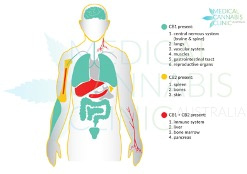What’s the difference between CBD and THC? Well, they’re related and they’re similar, but not the same.So, let’s look at each and in doing so we can see how they differ.
What’s the difference between CBD and THC
The short answer is that CBD isn’t psychoactive and THC is. CBD is short for cannabidiol. THC is short for tetrahydrocannabinol. Both are present in the hemp and cannabis plants. Hemp and cannabis come from the Cannabis sativa plant. Legal hemp must contain 0.3% THC, or less. CBD and THC are cannabinoids and both have therapeutic properties. However, they interact with CB receptors in your body’s endocannabinoid system (ECS) differently.
Each strain of hemp or cannabis has a different concentration of CBD and THC, which can also vary within the plant or from plant to plant. CBD can be derived from both hemp and cannabis, and neither version will cause you to get high. Researchers have identified more than 100 other cannabinoids that can influence the human body.
In addition, because people are different – body weight, health conditions, genetics and biochemistry – they respond differently to both CBD and THC. Also, the level of THC extracted from the marijuana plant is significantly higher than when extracted from the hemp plant. To be clear, THC is illegal everywhere in the United States. However, The 2018 Farm Bill made all derivatives, isomers and cannabinoids in hemp legal, provided the final product has less than 0.3% Delta 9 THC.
The ECS mechanics
Remember earlier I referred to the ECS, or endocannabinoid system? Well, we all have one and it’s what keeps our bodies in balance. The ECS relies on CB receptors (CB1 and CB2) that travel throughout the brain and body to tackle problems or deficiencies. Within the ECS, there are two primary endocannabinoids, arachidonylethanolamine (AEA), nicknamed anandamide from the Sanskrit word for bliss, and 2-arachidonylglycerol (2-AG). Your body produces them as needed, so it’s difficult to state what a typical quantity for each should be. The ECS, upon detecting an imbalance, produces cannabinoids that interact with receptors. A chemical process then targets and resolves the imbalance and returns the body to a state of homeostasis, or perfect balance.
What we know about CBD Receptors
CB1 is found mostly in the nervous system and brain. CB2 is found outside the brain and tends to monitor and regulate the immune system. When the ECS is functioning optimally, you’ll have a general sense of well-being and good health. Our bodies create endocannabinoids to stimulate the receptors. When the balance is off, the receptors can’t do their jobs. Illness or imbalance occurs.

How CBD and THC interact with CB receptors
CBD, doesn’t tend to bind with the receptors. Instead, it interacts with how receptors bind with THC, modulating the psychoactive effects. Beyond the endocannabinoid receptors, CBD activates other receptors and ion channels that stimulate positive effects. For instance, CBD can activate specific serotonin receptors to help alleviate symptoms such as anxiety, nausea, vomiting and the perception of pain.
THC does bind with CB1 and CB2 receptors, which can help relieve pain, nausea and insomnia. It can also help simulate the appetite. According to a recent study around THC and pain, “THC acts as a partial agonist at cannabinoid receptors (CB1 and CB2). A very high binding affinity of THC with the CB1 receptor appears to mediate its psychoactive properties (changes in mood or consciousness), memory processing, motor control, etc.” The down side is that THC can make you high, and that’s Illegal.
CBD and THC in topicals
Topicals are unique in that unlike other methods of using the compounds, they never reach the bloodstream. As you apply the topical and massage it into your skin, it penetrates beyond the surface, sinking into the dermal and subdermal layers. As a result, relief can occur within minutes instead of hours.
The CBD interacts with receptors and enzymes in the skin to ease pain and inflammation. THC binds to the receptors and alleviates pain symptoms. In essence, CBD mediates pain perception by altering the way THC binds to those receptors.
Lost Remedy uses CBD derived from hemp. We combine CBD with carrier and essential oils to make good use of all the components of CBD and the essential oils. In fact, this combo provides an entourage effect, which means the whole is greater than the sum of its parts.
Now you have a better idea of CBD and THC and their difference behaviors.
